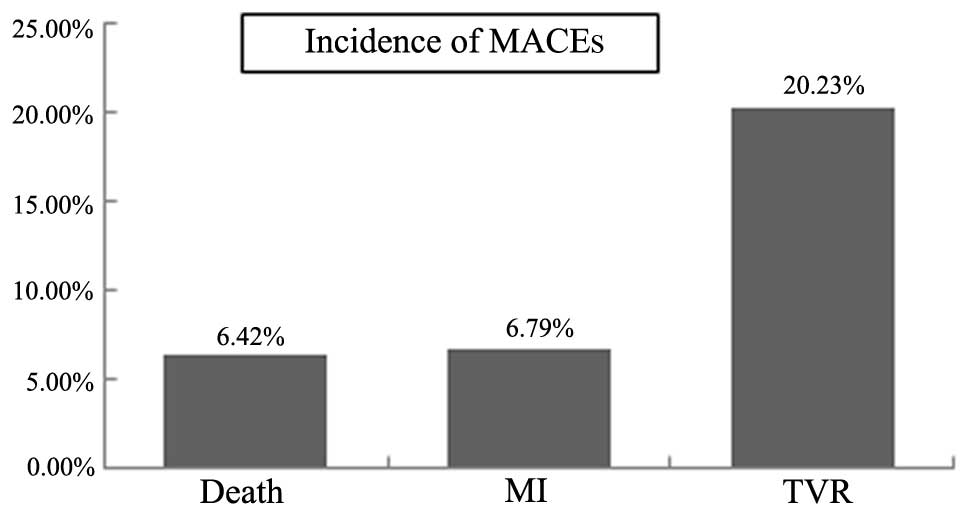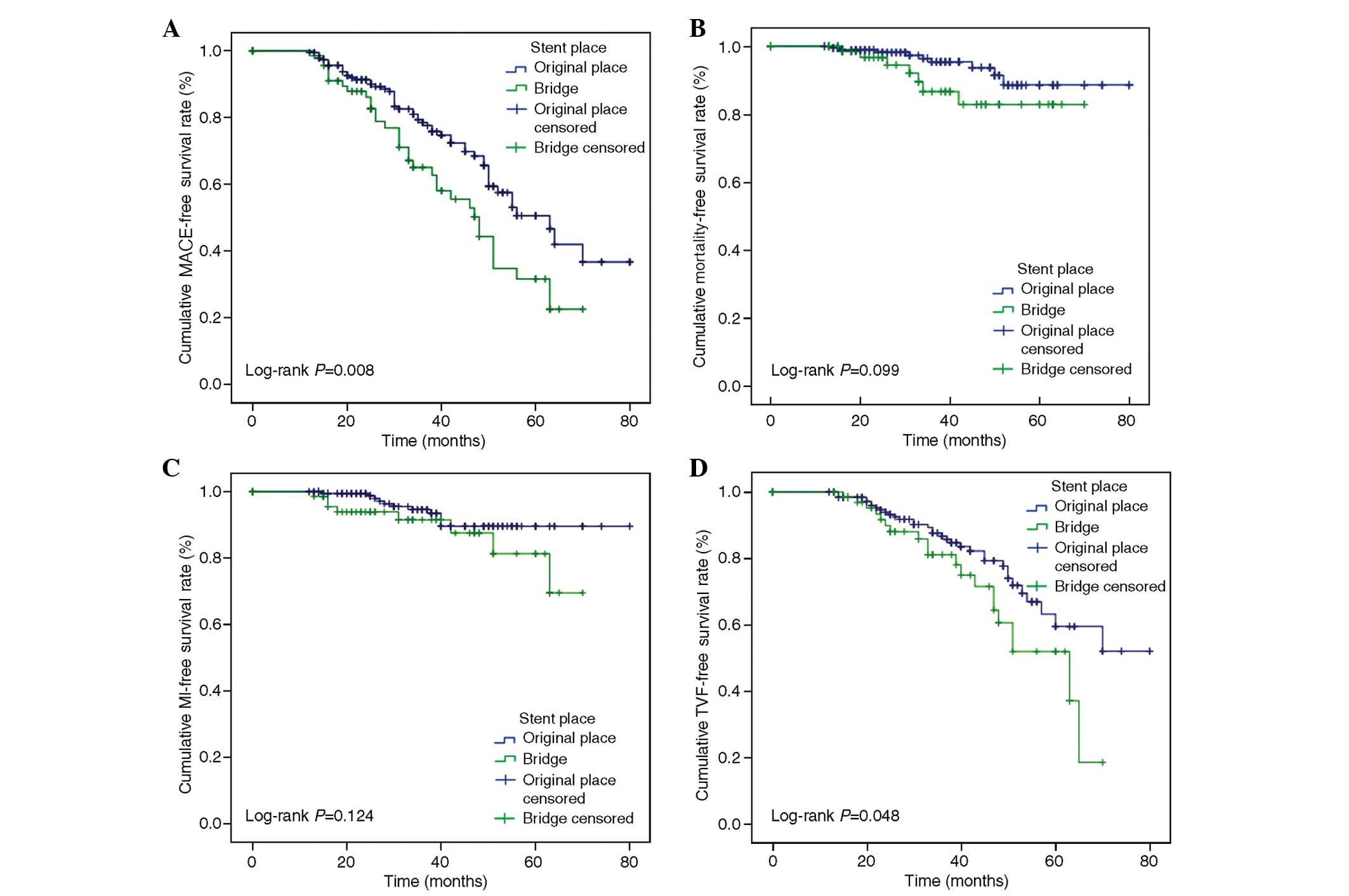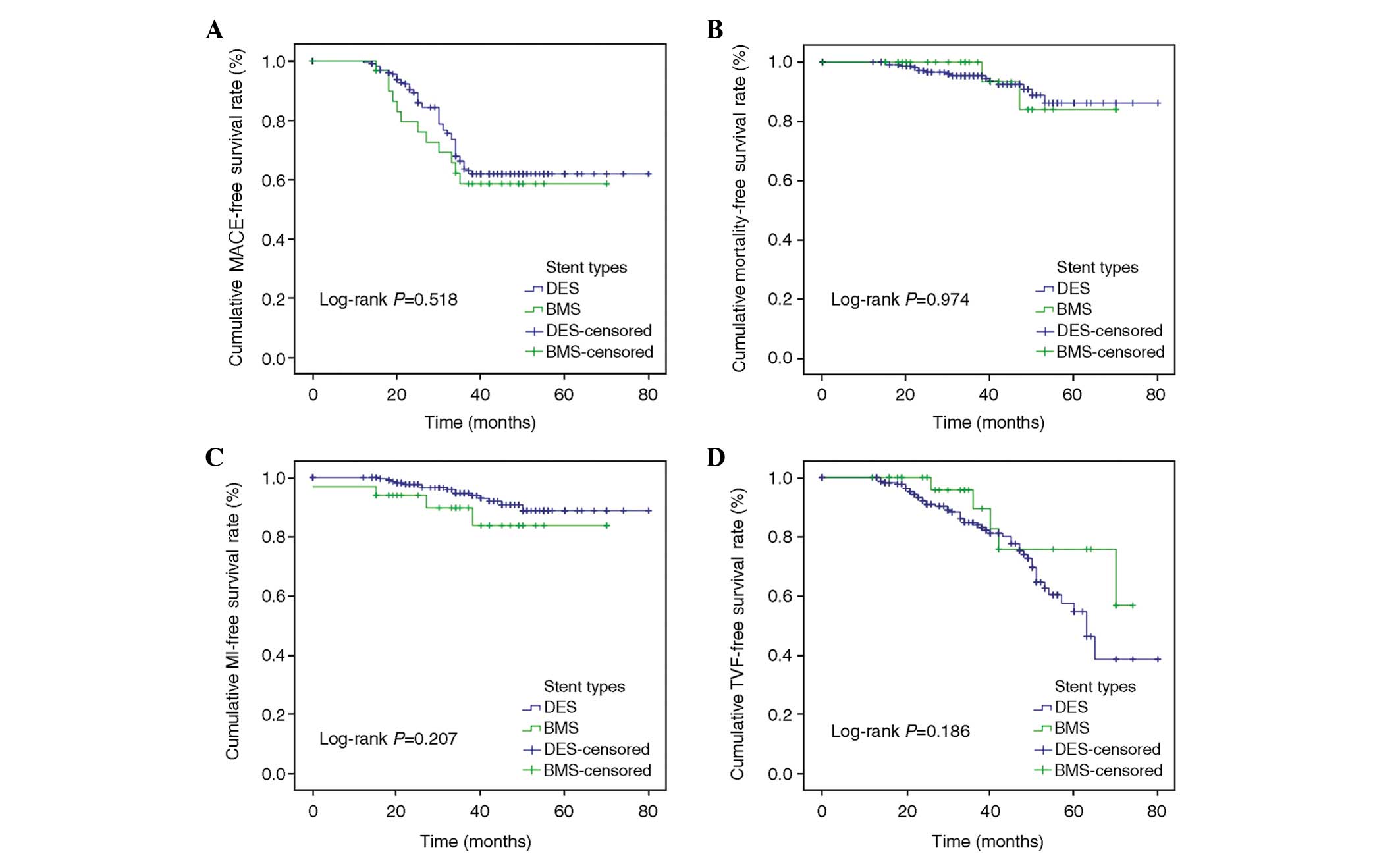|
1
|
Lee MS, Park SJ, Kandzari DE, et al:
Saphenous vein graft intervention. JACC Cardiovasc Interv.
8:831–843. 2011. View Article : Google Scholar
|
|
2
|
Campeau L, Enjalbert M, Lespérance J,
Vaislic C, Grondin CM and Bourassa MG: Atherosclerosis and late
closure of aortocoronary saphenous vein grafts: Sequential
angiographic studies at 2 weeks, 1 year, 5 to 7 years, and 10 to 12
years after surgery. Circulation. 68:111–117. 1983.
|
|
3
|
Fitzgibbon GM, Leach AJ, Kafka HP and Keon
WJ: Coronary bypass graft fate: longerm angiographic study. J Am
Coll Cardiol. 17:1075–1080. 1991. View Article : Google Scholar : PubMed/NCBI
|
|
4
|
Weintraub WS, Jones EL, Craver JM and
Guyton RA: Frequency of repeat coronary bypass or coronary
angioplasty after coronary artery bypass surgery using saphenous
venous grafts. Am J Cardiol. 73:103–112. 1994. View Article : Google Scholar : PubMed/NCBI
|
|
5
|
Goldman S, Zadina K, Moritz T, Ovitt T,
Sethi G, Copeland JG, et al: VA Cooperative Study Group
#207/297/364: Long-term patency of saphenous vein and left internal
mammary artery grafts after coronary bypass surgery: results from a
Department of Veterans Affairs Cooperative Study. J Am Coll
Cardiol. 44:2149–2156. 2004. View Article : Google Scholar : PubMed/NCBI
|
|
6
|
Fitzgibbon GM, Kafka HP, Leach AJ, Keon
WJ, Hooper GD and Burton JR: Coronary bypass graft fate and patient
outcome: angiographie follow-up of 5,065 grafts related to survival
and reoperation in 1,388 patients during 25 years. J Am Coll
Cardiol. 28:616–626. 1996. View Article : Google Scholar : PubMed/NCBI
|
|
7
|
Eagle KA, Guyton RA, Davidoff R, et al:
American College of Cardiology; American Heart Association: ACC/AHA
2004 guideline update for coronary artery bypass graft surgery: A
report of the American College of Cardiology/American Heart
Association Task Force on Practice Guidelines (Committee to Update
the 1999 Guidelines for Coronary Artery Bypass Graft Surgery).
Circulation. 110:e340–e437. 2004.PubMed/NCBI
|
|
8
|
Baim DS: Percutaneous treatment of
saphenous vein graft disease: The ongoing challenge. J Am Coll
Cardiol. 42:1370–1372. 2003. View Article : Google Scholar : PubMed/NCBI
|
|
9
|
Baldwin DE, Abbott JD, Trost JC, et al:
Comparison of drug-eluting and bare metal stents for saphenous vein
graft lesions (from the National Heart, Lung, and Blood Institute
Dynamic Registry). Am J Cardiol. 106:946–951. 2010. View Article : Google Scholar : PubMed/NCBI
|
|
10
|
Gyenes G, Norris CM and Graham MM:
APPROACH Investigators: Percutaneous revascularization improves
outcomes in patients with prior coronary artery bypass surgery.
Catheter Cardiovasc Interv. 82:E148–E154. 2013. View Article : Google Scholar : PubMed/NCBI
|
|
11
|
Hiscock M, Oqueli E and Dick R:
Percutaneous saphenous vein graft intervention - a review. Heart
Lung Circ. 16:S51–S55. 2007. View Article : Google Scholar : PubMed/NCBI
|
|
12
|
Sabik JF III, Blackstone E, Gillinoy M,
Smedira NG and Lytle BW: Occurrence and risk factors for
reintervention after coronary artery bypass grafting. Circulation.
114:1454–1460. 2006. View Article : Google Scholar
|
|
13
|
Pucelikova T, Mehran R, Kirtane A, et al:
Short- and long-term outcomes after stent-assisted percutaneous
treatment of saphenous vein grafts in the drug-eluting stent era.
Am J Cardiol. 101:63–68. 2008. View Article : Google Scholar : PubMed/NCBI
|
|
14
|
Meliga E, García-García H, Kukreja N, et
al: Chronic total occlusion treatment in post-CABG patients:
Saphenous vein graft versus native vessel recanalization-long-term
follow-up in the drug-eluting stent era. Catheter Cardiovasc
Interv. 70:21–25. 2007. View Article : Google Scholar : PubMed/NCBI
|
|
15
|
Hoffmann R, Hamm C, Nienaber CA, et al:
German Cypher Registry: Implantation of sirolimus-eluting stents in
saphenous vein grafts is associated with high clinical follow-up
event rates compared with treatment of native vessels. Coron Artery
Dis. 18:559–564. 2007. View Article : Google Scholar : PubMed/NCBI
|
|
16
|
Vermeesch P, Agostoni P, Verheye S, et al:
DELAYED RRISC (Death and Events at Long-term follow-up AnalYsis:
Extended Duration of the Reduction of Restenosis In Saphenous vein
grafts with Cypher stent) Investigators: Increased late mortality
after sirolimus-eluting stents versus bare-metal stents in diseased
saphenous vein grafts: Results from the randomized DELAYED RRISC
Trial. J Am Coll Cardiol. 50:261–267. 2007.PubMed/NCBI
|
|
17
|
Brilakis ES, Lichtenwalter C, de Lemos JA,
Roesle M, Obel O, Haagen D, et al: A randomized controlled trial of
a paclitaxel-eluting stent versus a similar bare-metal stent in
saphenous vein graft lesions the SOS (Stenting of Saphenous Vein
Grafts) trial. J Am Coll Cardiol. 53:919–928. 2009. View Article : Google Scholar : PubMed/NCBI
|
|
18
|
Mauri L, Kereiakes DJ, Yeh RW, et al: DAPT
Study Investigators: Twelve or 30 months of dual antiplatelet
therapy after drug-eluting stents. N Engl J Med. 371:2155–2166.
2014. View Article : Google Scholar : PubMed/NCBI
|
|
19
|
Morrison DA, Sethi G, Sacks J, et al:
Investigators of the Department of Veterans Affairs Cooperative
Study #385, angina With Extremely Serious Operative Mortality
Evaluation (AWESOME): Percutaneous coronary interventions versus
coronary bypass graft surgery for patients with medically
refractory myocardial ischemia and risk factors for adverse
outcomes with bypass. The VA AWESOME Multicenter Registry:
Comparison With the Randomized Clinical Trial. J Am Coll Cardiol.
39:266–273. 2002. View Article : Google Scholar : PubMed/NCBI
|
|
20
|
Yap CH, Sposato L, Akowuah E, et al:
Contemporary results show repeat coronary artery bypass grafting
remains a risk factor for operative mortality. Ann Thorac Surg.
87:1386–1391. 2009. View Article : Google Scholar : PubMed/NCBI
|
|
21
|
Runyan D, Gorges R, Feldman D, McCullough
PA, David S and Saba S: Long-term follow-up of lesion-specific
outcomes comparing drug-eluting stents and bare metal stents in
diseased saphenous vein grafts. Rev Cardiovasc Med. 14:1–6.
2013.PubMed/NCBI
|
|
22
|
Gupta S and Cigarroa JE: The quest for
optimal interventional strategy in saphenous vein graft
interventions - are we there yet? Catheter Cardiovasc Interv.
80:1118–1119. 2012. View Article : Google Scholar : PubMed/NCBI
|
|
23
|
Brilakis ES, Rao SV, Banerjee S, et al:
Percutaneous coronaryintervention in native arteries versus bypass
grafts in prior coronary artery bypass grafting patients: a report
from the National Cardiovascular Data Registry. JACC Cardiovasc
Interv. 4:844–850. 2011. View Article : Google Scholar : PubMed/NCBI
|
|
24
|
Ko DT, Guo H, Wijeysundera HC, Zia MI,
Džavík V, Chu MW, et al: Long-term safety and effectiveness of
drug-eluting stents for the treatment of saphenous vein grafts
disease: a population-based study. JACC Cardiovasc Interv.
4:965–973. 2011. View Article : Google Scholar : PubMed/NCBI
|
|
25
|
Hindnavis V, Cho SH and Goldberg S:
Saphenous vein graft intervention: a review. J Invasive Cardiol.
24:64–71. 2012.PubMed/NCBI
|
|
26
|
Ho PC, Lee AC and Fortuna R: Drug-eluting
stenting of saphenous vein graft versus native coronary artery
supplying the same myocardial perfusion territory: a pilot
retrospective 3-year follow-up. J Invasive Cardiol. 24:516–520.
2012.PubMed/NCBI
|
|
27
|
de Feyter PJ, van Suylen RJ, de Jaegere
PP, Topol EJ and Serruys PW: Balloon angioplasty for the treatment
of lesions in saphenous vein bypass grafts. J Am Coll Cardiol.
21:1539–1549. 1993. View Article : Google Scholar : PubMed/NCBI
|
|
28
|
Xanthopoulou I, Davlouros P, Tsigkas G,
Panagiotou A, Hahalis G and Alexopoulos D: Long-term clinical
outcome after percutaneous coronary intervention in grafts vs
native vessels in patients with previous coronary artery bypass
grafting. Can J Cardiol. 27:716–724. 2011. View Article : Google Scholar : PubMed/NCBI
|
|
29
|
Leal S, Campante Teles R, Calé R, Sousa
PJ, Brito J, Raposo L, et al: ACROSS Registry Investigators:
Percutaneous revascularization strategies in saphenous vein graft
lesions: long-term results. Rev Port Cardiol. 31:11–18.
2012.PubMed/NCBI
|
|
30
|
Vermeersch P, Agostoni P, et al:
Randomized double-blind comparison of sirolimus-eluting stent
versus bare-metal stent implantation in diseased saphenous vein
grafts: six-month angiographic, intravascular ultrasound and
clinical follow-up of the RRISC Trial. J Am Coll Cardiol.
48:2423–2431. 2006. View Article : Google Scholar : PubMed/NCBI
|
|
31
|
Hakeem A, Helmy T, Munsif S, Bhatti S,
Mazraeshahi R, Cilingiroglu M, et al: Safety and efficacy of drug
eluting stents compared with bare metal stents for saphenous vein
graft interventions: a comprehensive meta-analysis of randomized
trials and observational studies comprising 7,994 patients.
Catheter Cardiovasc Interv. 77:343–355. 2011. View Article : Google Scholar : PubMed/NCBI
|
|
32
|
Lozano I, García-Camarero T, Carrillo P,
Baz JA, de la Torre JM, López-Palop R, et al: Comparison of
drug-eluting and bare metal stents in saphenous vein grafts.
Immediate and long-term results. Rev Esp Cardiol. 62:39–47.
2009.[(In Spanish)]. View Article : Google Scholar : PubMed/NCBI
|
|
33
|
Goswami NJ, Gaffigan M, Berrio G, Plessa
AL, Pfeiffer AM, Markwell SJ and Mishkel GJ: Long-term outcomes of
drug-eluting stents versus bare-metal stents in saphenous vein
graft disease: results from the Prairie ‘Real World’ Stent
Registry. Catheter Cardiovasc Interv. 75:93–100. 2010.PubMed/NCBI
|

















